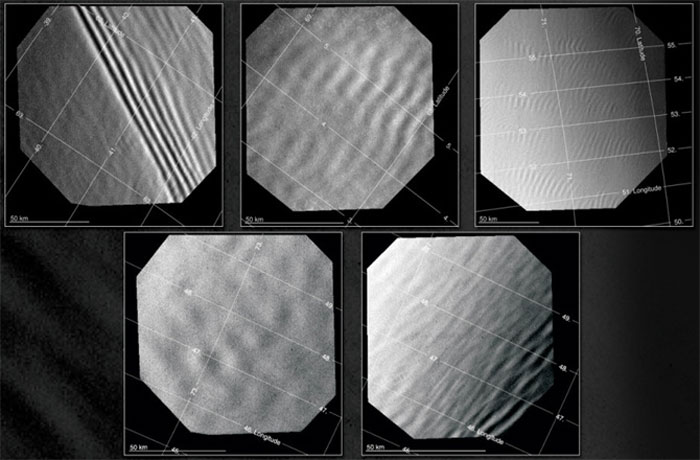.

Long, medium, short and irregular gravity waves observed in Venus’ atmosphere.
.
Searing hot Venus may not have any liquid oceans on its surface — at least it hasn’t within the past several billion years — but its super-dense atmosphere acts a bit like an ocean… complete with ripples and waves kicked up by winds blowing over some of its tallest and most rugged mountains.
Instruments aboard the European Space Agency’s Venus Express orbiter have detected various types of wave structures propagating through Venus’ thick cloud layers. These so-called “gravity waves“ are also found in Earth’s atmosphere, and can be caused by both the upwelling of warm air from below or by horizontal movement over a surface feature, such as a mountain.
“We believe that these waves are at least partly associated with atmospheric flow over Ishtar Terra, an upland region which includes the highest mountains on Venus,” said Silvia Tellmann of the Rheinisches Institut für Umweltforschung, University of Cologne, Germany, lead author of a 2012 study. ”We don’t yet fully understand how such topographic forcing can extend to high levels, but it seems likely to be one of the key processes for the generation of gravity waves at high northern latitudes on Venus. The waves may form when a stable air flow passes over the mountains.”
First observed in 1985 by two Soviet Vega balloon probes, this atmospheric phenomenon has now also been confirmed by the Venus Monitoring Camera (VMC) on ESA’s Venus Express.
These gravity waves can only exist in a stably stratified, layered atmosphere. Here on Earth they’re often manifested as “wave trains” — a series of regularly-spaced waves traveling in the same direction.Observed in multiple wavelengths (ultraviolet, visible, and near-infrared), wave trains on Venus have so far mostly been found 37-43 miles (60-70 km) altitude and at higher, colder latitudes, 60-80 degrees north — which is directly above the rugged, complex geography of the Ishtar Terra highlands.
“This is an exciting result because it strengthens the case that topography is likely to be a significant influence on the atmospheric circulation of Venus,” said Håkan Svedhem, ESA’s project scientist for Venus Express.
Venus Express is Europe’s first mission to Venus. It was launched from Baikonur Cosmodrome on Nov. 9, 2005 on a Soyuz-Fregat launcher and established orbit around Venus on April 11, 2006.
The new study, led by Arianna Piccialli of the Laboratoire Atmosphères, Milieux, Observations Spatiales (LATMOS) in Guyancourt, France, has been published in the January 2014 issue of Icarus.
Quelle: D-News
5161 Views
